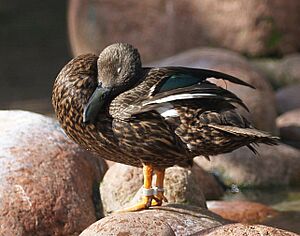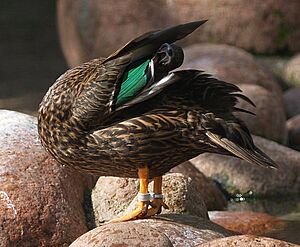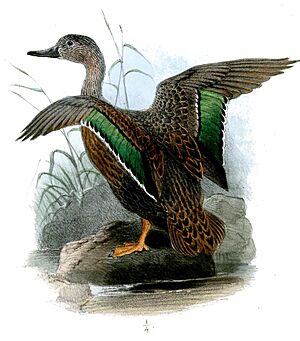Meller's duck facts for kids
Quick facts for kids Meller's duck |
|
|---|---|
 |
|
| Sexes look alike. Note lack of supercilium. | |
 |
|
| Note color of speculum feathers | |
| Conservation status | |
| Scientific classification | |
| Genus: |
Anas
|
| Species: |
melleri
|
 |
|
| Distribution of the Meller's duck | |
| Synonyms | |
|
Anas platyrhynchos melleri |
|
The Meller's duck (scientific name: Anas melleri) is a special type of dabbling duck. These ducks are found only in eastern Madagascar. They once lived on the island of Mauritius too, but that group is almost gone. This is because their homes are disappearing, and wild domestic ducks are competing with them. The duck's name comes from a botanist named Charles James Meller. Its scientific genus name, Anas, is a Latin word for "duck."
Contents
What Does the Meller's Duck Look Like?

The Meller's duck looks a lot like a large female mallard duck. It is usually about 55 to 65 centimeters (22 to 26 inches) long. This makes it a bit bigger than a mallard. It is one of the largest ducks in its group.
Unlike many ducks related to the mallard, Meller's ducks do not have a light stripe above their eyes. This stripe is called a supercilium. Their special wing feathers, called speculum feathers, are green. These feathers have a white border, just like a mallard's.
The Meller's duck has a dark brown body. Its feathers have narrow lighter edges on its upper parts. The edges are wider on its lower parts. Its bill is light gray with darker spots near its head. Its feet and legs are orange.
How Does the Meller's Duck Behave?
Meller's ducks usually lay eggs and raise their young for most of the year in Madagascar. This depends on the weather and local conditions. However, in Mauritius, they have been seen breeding in October and November.
Unlike most of their close duck relatives, Meller's ducks are very protective of their territory. This is especially true during the breeding season. Also, a male and female Meller's duck will stay together as a pair. They remain together until their ducklings are old enough to live on their own.
Why is the Meller's Duck Endangered?
The Meller's duck is listed as an endangered species. This means it is at high risk of becoming extinct. The IUCN Red List tracks its status. One of the main places these ducks lived was the Lac Alaotra wetlands. This area in Madagascar has lost a lot of its natural habitat. This happened during the second half of the 1900s. Because of this, the number of water birds in that area has dropped a lot.
For a long time, people did not think this duck needed special protection. They mistakenly thought it was just a different type of mallard. This made it harder to help them. Meller's ducks are not very popular with people who raise birds. This is because they have plain feathers and are very territorial. However, they can breed easily in zoos if they have enough space.
There is a special program to help breed these ducks in zoos. It is called the European Endangered Species Programme. You can sometimes see Meller's ducks in zoos in Europe. Some of these zoos include Cologne Zoo, Edinburgh Zoo, Durrell Wildlife Park, and Zürich Zoo.
Meller's Duck Family Tree
Because the Meller's duck looks like a female mallard, people used to think they were very closely related. Some even thought the Meller's duck was just a different color version of the mallard. This idea came from seeing them create mixed-breed ducklings in unusual situations.
Today, scientists know that the Meller's duck is a very unique species. They have studied its behavior and its DNA. These studies show that it is one of the most distinct ducks in the mallard group. Its closest relative seems to be the yellow-billed duck. Both of these ducks, along with the African black duck, are early branches on the mallard family tree. However, their exact relationships are still being studied.


